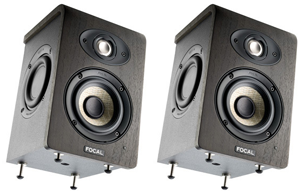Best Studio Monitors 2017

The pro audio market is flooded with studio monitors. Companies cut every corner imaginable to make a profit, resulting in sub-par gear. Luckily, there are still a few obsessed with delivering sonic reality. You don't have to spend a fortune to achieve hear the truth of what you are working on. The following studio monitors have already been discovered and praised in the forums and online. Those who have done their homework will already know about near-field monitors and how the smaller ones translate incredibly well to real-world playback systems. This "best in the world" list targets the low to mid budgets and the less-than-perfect monitoring environment.

Equator Audio Research D5
The best entry level studio monitor is the D5 from Equator Audio Research, which completely dominates the $400 price point. The founder of Equator is best known for designing the Event 20/20's which raised the home studio quality bar back in the 90'S. The D5s have garnered big praise in the Pro Audio community. The tweeter is actually mounted inside the woofer and sits motionless as the woofer moves freely. The main advantage of this design is the absence of phase issues. The clarity of the D5 is superb with the 53Hz to 20kHz frequency range handling most game audio projects. The five inch woofer is easily comparable to real-world playback systems while the tweeter, dead center, seamlessly handles the upper spectrum with tonal accuracy. Pro features include balanced XLR and balanced/unbalanced TRS inputs as well as a boundary selection switch to select the appropriate monitor response for their placement (in a corner, in front of a wall, free standing). Equator is unique in that they manufacture and ship direct from their own factory. With custom designed components, internal DSP, 100w of power, and 103 dB of SPL, the D5s deliver a huge bang for little buck. When it comes to low-cost studio monitors, the D5s are in a league of their own, period.

Focal Professional Shape 40
For budgets around the 1K range, the Focal Shape 40's are a strong choice. Focal needs no introduction in the high-end studio monitor market and these improve upon the discontinued CMS40's which made waves with everyone from bedroom producers to celebrity engineers. The Shape 40's include the side woofers and a wooden design as well as adjustable, padded feet. As the most compact monitor of the Focal Professional range, the Shape 40s feature a 60Hz-35kHz frequency response. They are revealing across the entire spectrum, particularly with extreme high frequencies, but the bass boost function is quite possibly the most natural ever heard in a compact monitor. These translate incredibly well to smaller speakers, which are the most common consumer speaker size. It is imperative that your audio content translate well to real-world playback systems. Focal use only the best materials for their drivers and the LF/HF shelving options on the Shape 40 make them a powerful tool for the game audio professional.

Dynaudio Lyd 7
The Lyd 7 from Dynaudio improves upon their classic B5 MKIII and is a strong contender for the "best powered monitors on earth". Dynaudio is based in Denmark and known for clinical levels of sonic accuracy, due in part to their handcrafted drivers. The seven inch woofer and 1.1" soft dome tweeter deliver a tight, 45Hz to 22kHz frequency response. Just as advertised, the Lyd 7 excels at low volume precision, making them perfect for smaller rooms and home studios. The position switch allows for placement within 50 cm of a wall or free standing. The lack of coloration on these allows for extended periods of work without listener fatigue. The sound balance feature lets you select from bright, neutral or dark tonality. Adjust sensitivity or add some bass extension, all from the back panel. The stereo image is remarkably phase-accurate with a neutrality that makes them perfect for any serious audio work.
Conclusion
Keep in mind that it's not enough to have great studio monitors. The biggest problem with home and pro studios is low-end resonance problems, which distort the bass frequencies and impair the ability to mix accurately. There is a reason that Acousticians are paid millions to construct studios from the ground up. The good news is that professional game audio work can be produced on near-fields in most rooms at reasonable volumes. Try to eliminate early reflections near the mix position. For those on a tight budget, moving blankets work amazingly well. A well rounded monitoring environment will include pro headphones, which provide a a perfect acoustic environment right on your head. Pro studio headphones can reach down to 5hz, allowing for greater accuracy work in the lower registers as well as the top of the spectrum.
Related:





